Level 2 Gallery is a small exhibition space that keeps me coming back to Tate Modern in London. Its entrance is hidden by one of the exits of the Tate and if you don’t know of its existence you’ve probably passed by it on your way from the shop to the Millennium Bridge without noticing.
The gallery is now showing Out of Place, an exhibition in which four artists explore the relationship between political forces and personal/collective histories by looking at urban space, architectural structures and the condition of displacement.
Each of the artist is interesting in their own way but i’ll focus on only two of them:
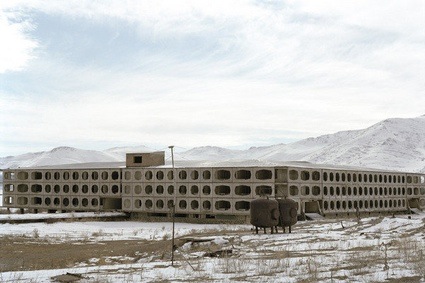 Hrair Sarkissian, Untitled (In Between series), 2007
Hrair Sarkissian, Untitled (In Between series), 2007
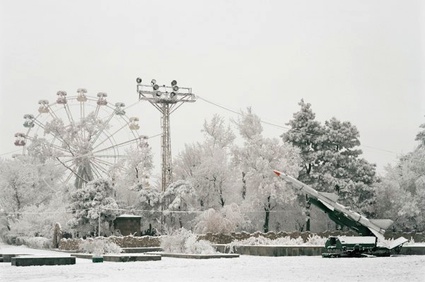 Hrair Sarkissian, Untitled (In Between series), 2007
Hrair Sarkissian, Untitled (In Between series), 2007
Hrair Sarkissian‘s large prints from the In Between series grab the visitor’s attention as soon as they enter the main exhibition room. Sarkissian is a Syrian artist of Armenian origin. He learnt of Armenia through family stories of a great and proud ‘Mother Armenia’. But once he actually visited this former republic of the Soviet Union, the artist found it hard to reconcile the ideals of the Armenian diaspora with the landscapes and situations he encountered.
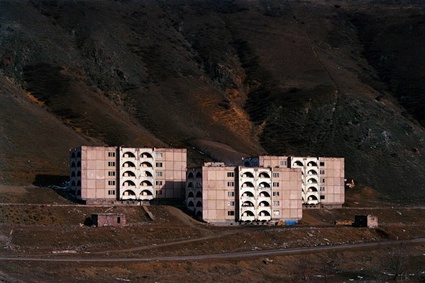 Hrair Sarkissian, Untitled (In Between series), 2007
Hrair Sarkissian, Untitled (In Between series), 2007
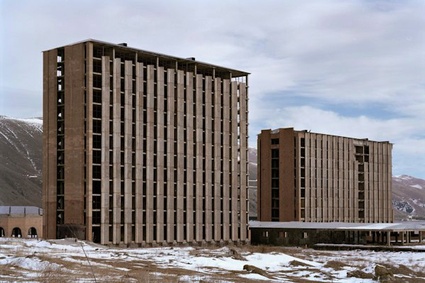 Hrair Sarkissian, Untitled (In Between series), 2007
Hrair Sarkissian, Untitled (In Between series), 2007
His photos show austere Soviet-style buildings left abandoned in the quiet hills and valleys of rural Armenia.
As Kasia Redzisz wrote in her essay for the exhibition, The incompatibility of his relatives’ memories and the physical reality of the ruins of the Soviet empire caused him to experience profound disorientation. In his series In Between 2007, Sarkissian juxtaposes abandoned, monumental constructions and the epic unchanging landscape. The contrast poses a question about the foundations on which national or cultural identity can be built.
Ahlam Shibli takes on an entirely different subject.
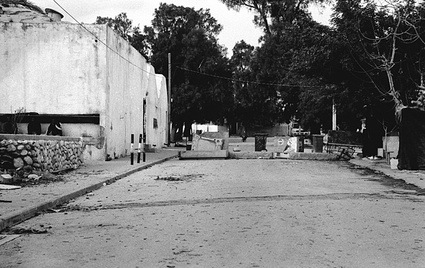 Ahlam Shibli, Untitled (Goter no. 19), Tel as-Sab’a, al-Naqab, Palestine, 2002-03
Ahlam Shibli, Untitled (Goter no. 19), Tel as-Sab’a, al-Naqab, Palestine, 2002-03
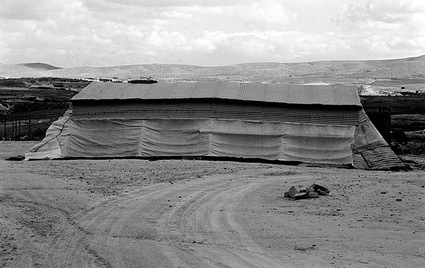 Ahlam Shibli, Untitled (Goter no. 31), Umm Mitnan, al-Naqab, Palestine, 2002-03
Ahlam Shibli, Untitled (Goter no. 31), Umm Mitnan, al-Naqab, Palestine, 2002-03
Her series Goter looks at the lives of Palestinians of Bedouin descent from al-Naqab (Negev). Local people believe that the word ‘goter’ is derived from ‘go there’, a command British soldiers often shouted to Bedouins during the mandate (1920-1948.)
Shibli’s images were taken both in townships, constructed by the Israeli administration to coral Palestinians displaced from their lands, and in unrecognised villages inhabited by those who refuse to be relocated, controlled and dispossessed of their traditional land.
The photographer explains in her statement for the series: The remaining half of the Palestinian Bedouin in the Naqab has so far refused to move to these townships, to avoid losing their lands and being subjected to culturally adverse and socially degrading living conditions. They live in more than 100 unrecognized villages, where the laws of the Jewish State prohibit them from building permanent structures, where houses are regularly demolished, fields deemed illegal by the authorities sprayed with toxic chemicals, families evicted from their homes, and where there is no public access to electricity, running water, or public services such as health care, sanitation and education beyond primary school level.
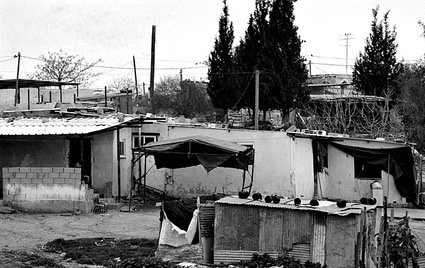 Ahlam Shibli, Untitled (Goter no. 24), al-Huzaiyil, al-Naqab, Palestine, 2002-03
Ahlam Shibli, Untitled (Goter no. 24), al-Huzaiyil, al-Naqab, Palestine, 2002-03
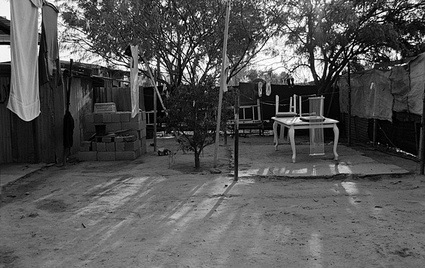 Ahlam Shibli, Untitled (Goter no. 16), ‘Amra, al-Naqab, Palestine, 2002-03
Ahlam Shibli, Untitled (Goter no. 16), ‘Amra, al-Naqab, Palestine, 2002-03
The Israeli government has long promoted the sedentarization of the Bedouin population. In 1963, Moshe Dayan said:
“We should transform the Bedouins into an urban proletariat – in industry, services, construction, and agriculture. 88% of the Israeli population are not farmers, let the Bedouin be like them. Indeed, this will be a radical move which means that the Bedouin would not live on his land with his herds, but would become an urban person who comes home in the afternoon and puts his slippers on. His children will get used to a father who wears pants, without a dagger, and who does not pick out their nits in public. They will go to school, their hair combed and parted. This will be a revolution, but it can be achieved in two generations.”
Dayan added, “Without coercion but with governmental direction … this phenomenon of the Bedouins will disappear.”
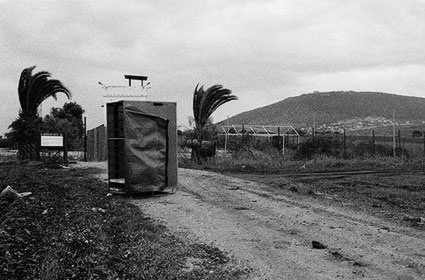 Ahlam Shibli, Untitled (The Valley no. 15), Arab al-Shibli, Palestine, 2007-8
Ahlam Shibli, Untitled (The Valley no. 15), Arab al-Shibli, Palestine, 2007-8
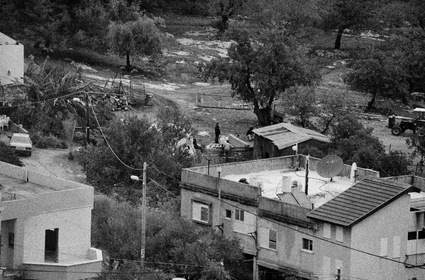 Ahlam Shibli, Untitled (The Valley no. 18), Arab al-Shibli, Palestine, 2007-8
Ahlam Shibli, Untitled (The Valley no. 18), Arab al-Shibli, Palestine, 2007-8
Shibli is showing a second series at Gallery 2. The Valley explores conditions in the village Arab al-Shibli, where Palestinians living under Israeli jurisdiction face relocation from their land.
Btw, if you’re interested in knowing more about the history and current situation of the Bedouins, have a look at Unrecognized. This short doc by Nirah Elyza Shirazipour) chronicles the last 60 years of Bedouin life in the Naqab.
un-titled magazine has a set of photos from the Goter series.
Out of Place is curated by Kasia Redzisz and Ala’ Younis and remains open at Tate Modern’s Level 2 Gallery until April 17, 2011.
Previously at Level 2 Gallery: The worst condition is to pass under a sword which is not one’s own.
